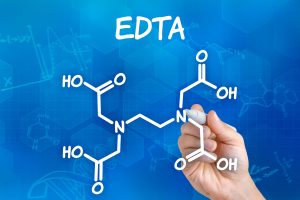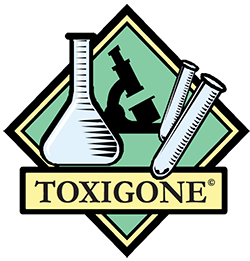Chelation is a concept from ancient times meaning “crab claw”, and in modern chemistry relates to “ligand chemistry.” Ligands are, in this application, substances that bind up toxic metals with opposite charges and carry them out of the body. Chelation therapy means an experimental medical therapy to restore cellular homeostasis through the use of intravenous, metal-binding and bio-inorganic agents such as ethylene diamine tetraacetic acid (EDTA). Some other examples of chelators are calcium EDTA, penicillamine, and sulfur complexing agents such as DMPS and DMSA(oral). The body also has its own sulfur based amino acid process via glutathione, and amino acids and mineral effects such as selenium. There are also other natural substances that can have a natural chelation-like effect such as chlorella and cilantro (both orally).
 This site currently has information on EDTA, based off of Dr. Elmer Cranton, MD’s work in the book Bypassing Bypass. Chelation is only FDA approved for heavy metal removal and there are no other claims made on this website for this therapy. All information is for informative purposes only.
This site currently has information on EDTA, based off of Dr. Elmer Cranton, MD’s work in the book Bypassing Bypass. Chelation is only FDA approved for heavy metal removal and there are no other claims made on this website for this therapy. All information is for informative purposes only.
What is Chelation?
- Chelation is a medical treatment that improves metabolic and circulatory function by removing toxic metals and abnormally located nutritional metallic ions from the body.
- Chelation literally means “to claw” from the greek and Latin roots
- This is relevant because Chelation uses an amino acid like substance called EDTA (ethylene diamine tetra-acetic acid) which binds to certain metals permanently in a “claw like” action in the blood stream
How does it work?
- Chelation works by intravenous infusion with EDTA, water and nutrients such as Vitamin C, Magnesium etc.
- The action is one of anti-oxidant effect because the EDTA binds metals in the blood (toxic such as cadmium, lead, aluminum etc.) (non-toxic such as iron, copper etc.).
- This is true because free floating metals speed up the free radical mechanism by changing oxidation states and thus damaging blood vessel walls and oxidizing good fats into bad fats (the majority of metals should be inside of the blood cells).
- This damaged area will more readily bind with these oxidized fats and may begin to accumulate in the vascular system.
- Vascular changes can be dramatic—via the laws of physics a 19% increase in vessel diameter will increase flow by 2x’s (note, small changes in flow do not show up on an arteriogram p.223 Cranton).
How do those metals get there?
- Some are from toxic exposure, but the normal metals can be from blood cells breaking and releasing their contents, usually through trauma or low oxygen (p.224).
- Iron and copper are especially known to increase fat peroxidation when in the free form.
- Oxygen states change metals into forms that then speed enzyme and free radical action.
- EDTA can reduce free radical action by 1 million times (p.61)
What about binding of calcium?
- This is not the main action of EDTA, although many claim this is the roto-rooter effect on the arteries. Actually the main action (still not fully known) is that of anti-oxidant by removing excess metals in the blood and stored in close proximity to the blood.
- It is true that EDTA binds minimally calcium, but it has a lower affinity for calcium in the presence of other metals in the blood (p.126).
- The Calcium that is bound causes a temporary drop in blood levels, with a long-term increase because of pulsatile stimulation in parathyroid activity.This can actually help to strengthen bone because of net new bone formation (p.222).
- While doing chelation therapy it is wise to take a calcium/magnesium supplement, except on days of treatment.
Is it Safe?
- As long as the practitioner follows the ACAM protocols and runs labs to track the progress along with sound clinical judgment—it is safe.
- The literature shows 25 fatalities out of 400,000 – 500,000 patients and well over 6 millions treatments, and those were due to no protocols resulting in too high amounts of EDTA.
- In summary, there are less problems in 6 million EDTA treatments than there are with aspirin (1/100th of a % risk p.128).
What else can help chelation?
- In the long run, there are certain lifestyle changes (stop smoking, drinking etc.) that can greatly aid recovery from disease.
- Chelation is usually changed to a maintenance program after a certain amount of IV’s in a series.
- Exercise is a long term helping factor
- Eating more fresh foods and less fried and processed foods helps
- Certain oral antioxidants and heart friendly herbal formulations are beneficial.
- More Info: * This information comes from Bypassing Bypass by Elmer Cranton, MD.
